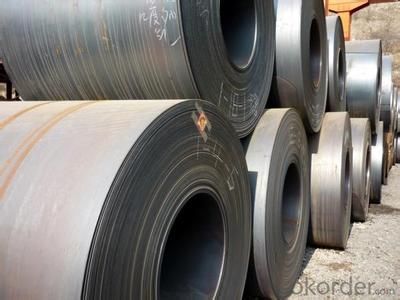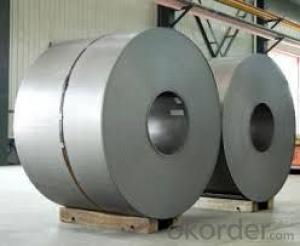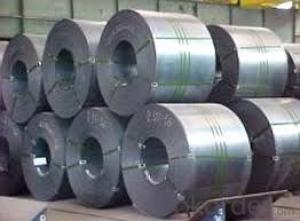hot rolled steel sheet - SAE 1006/1008
- Loading Port:
- China main port
- Payment Terms:
- TT OR LC
- Min Order Qty:
- 30 m.t.
- Supply Capability:
- 500000 m.t./month
OKorder Service Pledge
OKorder Financial Service
You Might Also Like
Product Description:
Rolled to its final dimensions while it’s hot enough to scale, our hot-rolled steel is an amalgamation of the various qualities of steel. It can be in the form of plates, sheets and coils.
Description:
Product: | Hot Rolled Steel Coils/Sheets |
Material: | Q195,Q235,A36,SS400,S235JR,Q345,ST37-2, CCSB etc |
Standard : | JIS G3002 GB/T251B |
Technique: | hot rolled |
Thickness | 1.2mm to 200mm |
Tolerance of thickness: | :+/-0.03mm |
Width: | 750mm-2000mm |
Tolerance of width: | :+/-5.00mm (aiming to +/-2.00mm) |
Normal width: | 914mm, 1000mm, 1200mm, 1219mm, 1250mm,1500mm |
Length: | According to requirement |
Coil ID: | 508mm-610mm |
Coil Weight: | 10-25 Metric Tons |
Surface: | Black, Chromate, fingerprint resistant treatment, slight oiled or non-oiled, dry |
Port of Loading: | Tianjin/Shanghai port |
Packaging Details: | Standard export packing or according to the clients required |
Delivery Time | Within 30 days after received 30% deposit or workable L/C |
Payment Terms: | L/C,T/T |
Image:


Our Hot-Rolled Steel Sheets and Coils are applied to a wide range of uses such as automobile, electrical appliance, machinery manufacturing, container manufacturing, shipbuilding, bridge, pipeline, and receive high acclaim from our customers for its excellent quality.
- Q:What is the typical yield strength of steel sheets?
- The yield strength of steel sheets can vary depending on the grade and type of steel used, with mild steel sheets commonly used in construction and manufacturing having a typical yield strength of around 250 megapascals (MPa) or 36,000 pounds per square inch (psi). Higher strength steels, like high-strength low-alloy (HSLA) steels or advanced high-strength steels (AHSS), can exhibit yield strengths ranging from 300 to 600 MPa (43,500 to 87,000 psi) or even higher. It is important to note that these values are general estimates and specific steel grades may possess slightly different yield strengths.
- Q:What are the different storage methods for steel sheets?
- There are several different storage methods for steel sheets, including vertical storage racks, horizontal storage racks, cantilever racks, shelving systems, and pallet racking. Each method offers distinct advantages in terms of space utilization, ease of access, and efficient handling of the steel sheets. The choice of storage method depends on the size, weight, and quantity of steel sheets, as well as the available space and specific requirements of the facility.
- Q:What is the difference between a hot rolled and pickled steel sheet?
- A hot rolled steel sheet is made by rolling a heated slab of steel through a series of large rollers, resulting in a thick and rough surface finish. On the other hand, a pickled steel sheet undergoes an additional process called pickling, where the surface of the hot rolled steel is treated with an acid solution to remove impurities and create a smooth and clean surface finish. So, the main difference between the two is the surface finish - hot rolled steel has a rougher surface, while pickled steel has a smoother and cleaner surface.
- Q:Are steel sheets suitable for architectural projects?
- Architectural projects can indeed utilize steel sheets as they offer numerous advantages. Steel, being a versatile and durable material, is highly suitable for such applications. First and foremost, steel sheets possess immense strength, enabling them to bear heavy loads. This makes them perfect for structural elements in buildings. The high strength-to-weight ratio of steel sheets allows for the creation of large and open spaces without the need for excessive supporting columns or walls. Consequently, steel sheets are ideal for constructing expansive interior spaces like atriums, stadiums, and other architectural projects. Furthermore, steel sheets can be easily shaped and formed into various architectural designs. They can be curved, rolled, or bent to fashion unique and intricate structures. Steel's malleability empowers architects and designers to challenge conventional building designs and create visually stunning and innovative structures. Moreover, steel sheets exhibit resistance to corrosion, weathering, and fire, making them suitable for outdoor applications and ensuring the longevity of architectural projects. The durability of steel also translates into minimal maintenance requirements throughout its lifespan, resulting in long-term cost savings. In addition, steel sheets offer a wide range of finishes, textures, and colors, facilitating customization and aesthetic versatility in architectural projects. Whether aiming for a sleek and modern design or a rustic and industrial look, steel sheets can be tailored to meet the desired aesthetic requirements of the project. To sum up, steel sheets are an excellent choice for architectural projects owing to their strength, versatility, durability, and aesthetic appeal. Their ability to withstand heavy loads, be shaped into various designs, resist corrosion and fire, and offer customization options make them a favored material for architects and designers to turn their visions into reality.
- Q:What are the different surface finishes for stainless steel sheets?
- Some common surface finishes for stainless steel sheets include brushed, mirror, satin, and bead blasted.
- Q:How thick are steel sheets typically?
- Steel sheets can vary in thickness depending on their intended use, but they typically range from 0.5 to 6 millimeters thick.
- Q:Are the steel sheets suitable for outdoor signage?
- Yes, steel sheets are generally suitable for outdoor signage due to their durability, weather resistance, and ability to withstand harsh environmental conditions.
- Q:Are steel sheets suitable for high-temperature applications?
- Yes, steel sheets are generally suitable for high-temperature applications due to their high melting point and excellent heat resistance.
- Q:Can steel sheets be used for noise reduction purposes?
- Yes, steel sheets can be used for noise reduction purposes. Steel is a dense and rigid material that has good sound insulation properties. When properly installed as barriers or enclosures, steel sheets can effectively block and absorb sound waves, reducing noise levels in various applications including buildings, machinery, and vehicles.
- Q:What are the different types of steel sheet finishes for industrial applications?
- Various types of steel sheet finishes are commonly utilized in industrial applications for different purposes. These finishes are applied to steel sheets to improve their appearance, safeguard against corrosion, enhance paint adhesion, and offer other functional advantages. Among the most frequently employed steel sheet finishes are: 1. Hot Rolled: Achieved by subjecting the steel to high temperatures in a furnace, followed by rapid cooling. This process creates a rough, scaled surface suitable for applications where appearance is not the primary concern. 2. Cold Rolled: Processed at room temperature, resulting in a smooth and clean surface. Cold-rolled steel sheets are often used when a high-quality surface finish is required. 3. Galvanized: Involves applying a layer of zinc to the steel sheet to protect against corrosion. Widely used in construction, automotive, and manufacturing industries where durability and resistance to rust are crucial. 4. Electro-galvanized: Similar to galvanizing, this process coats the steel with zinc. However, it utilizes an electric current to deposit a thinner and more controlled zinc coating onto the steel surface. 5. Stainless Steel: Known for its high corrosion resistance, stainless steel sheets are ideal for use in harsh environments. They can be finished with various surface textures, including brushed, mirror, and patterned finishes. 6. Pickled and Oiled: This finish removes any oxide scale from the steel surface using an acid solution and applies an oil coating to prevent rust formation. Commonly used in automotive and construction industries. 7. Painted: Steel sheets can be finished with a layer of paint, which enhances their appearance and provides additional protection against corrosion. The choice of paint depends on the application and desired finish. It is important to note that the examples mentioned above are just a few of the steel sheet finishes used in industrial applications. Different finishes are selected based on specific requirements, such as aesthetics, corrosion resistance, durability, and cost-effectiveness.
1. Manufacturer Overview |
|
|---|---|
| Location | |
| Year Established | |
| Annual Output Value | |
| Main Markets | |
| Company Certifications | |
2. Manufacturer Certificates |
|
|---|---|
| a) Certification Name | |
| Range | |
| Reference | |
| Validity Period | |
3. Manufacturer Capability |
|
|---|---|
| a)Trade Capacity | |
| Nearest Port | |
| Export Percentage | |
| No.of Employees in Trade Department | |
| Language Spoken: | |
| b)Factory Information | |
| Factory Size: | |
| No. of Production Lines | |
| Contract Manufacturing | |
| Product Price Range | |
Send your message to us
hot rolled steel sheet - SAE 1006/1008
- Loading Port:
- China main port
- Payment Terms:
- TT OR LC
- Min Order Qty:
- 30 m.t.
- Supply Capability:
- 500000 m.t./month
OKorder Service Pledge
OKorder Financial Service
Similar products
New products
Hot products
Related keywords
































